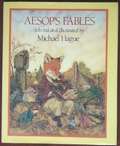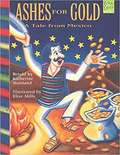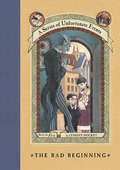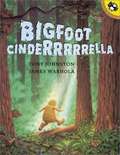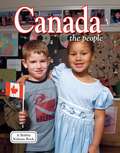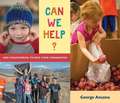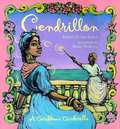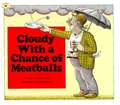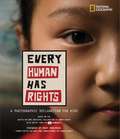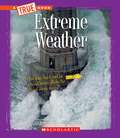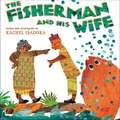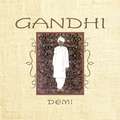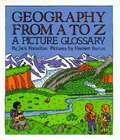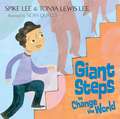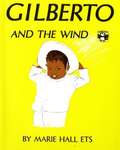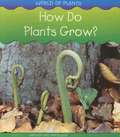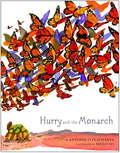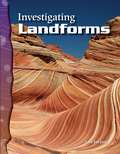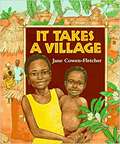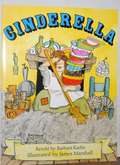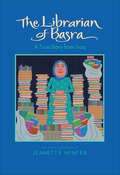Special Collections
District List: DCPS - Second Grade Unit Text List
Description: District of Columbia Public Schools Unit Text List for students in 2nd Grade. #dcps
- Table View
- List View
Aesop's Fables
by Michael Hague and Aesop AesopThe noted illustrator presents thirteen of Aesop's most familiar fables.
Ashes for Gold
by Katherine MaitlandTricked by a clever acquaintance, a poor Mexican still manages to turn ashes into gold.
The Bad Beginning
by Lemony Snicket and Brett HelquistImagine tales so terrible that as many as fifty million innocents have been ruined by them - tales so indelibly horrid that the New York Times bestseller list has been unable to rid itself of them for seven years.
Now imagine if this scourge suddenly became available in a shameful new edition so sensational, so irresistible, so riddled with lurid new pictures that even a common urchin would wish for it. Who among us would be safe?
Begin at the beginning - even if it is a bad one - with the first in A Series of Unfortunate Events.
Bigfoot Cinderrrrrella
by Tony JohnstonIn the old growth forest, a dashing Bigfoot prince searches for his Bigfoot princess. Rrrrrella, who also lives in the forest, would be a perfect match. But can she get past her ugly stepsisters to win the prince's heart?
Canada
by Bobbie KalmanUpdated facts and statistics support this fascinating portrayal of a nation built on immigration. Important issues that must be resolved with the Native peoples are sensitively portrayed.
Can We Help?
by George AnconaReal kids make a real difference in their communities in this vibrantly photographed chronicle by George Ancona.
George Ancona celebrates the joy of kids giving back. In one after-school program, middle-school students mentor and tutor younger children. Via a special partnership, schoolchildren help professionals train assistance dogs for people with disabilities. At a community farm, families plant, grow, and harvest produce for soup kitchens and charities. In these and other examples of volunteering, kids of all ages work together knitting hats and scarves for those who could use warm clothes, packing hot meals to deliver to housebound people, and keeping roadways clean. Young humanitarians reading these accounts may well be inspired to find ways that they can help, too.
Cendrillon
by Robert D. San SouciYou may think you know this story I am going to tell you, but you have not heard it for true. I was there. So I will tell you the truth of it. Here. Now.
Cloudy With a Chance of Meatballs
by Judi Barrett and Ron BarrettLife is delicious in the town of Chewandswallow where it rains soup and juice, snows mashed potatoes, and blows storms of hamburgers--until the weather takes a turn for the worse. Images and image descriptions available.
Every Human Has Rights
by Mary Robinson and National Geographic Editors and Elderslie Township Historical Society StaffThe 30 rights set down in 1948 by the United Nations are incredibly powerful. According to the U.N., every human–just by virtue of being human–is entitled to freedom, a fair government, a decent standard of living, work, play, and education, freedom to come and go as we please and to associate with anyone we please, and the right to express ourselves freely. Every Human Has Rights offers kids an accessibly written list of these rights, commentary–much of it deeply emotional–by other kids, and richly evocative photography illustrating each right. At the end of this deceptively simple book, kids will know–and feel–that regardless of individual differences and circumstances, each person is valuable and worthy of respect.
Extreme Weather
by Ann O. SquireEvery day, the world's scientists are working to solve some of the most thrilling mysteries on Earth. This True Book series highlights some of the incredible ways that scientists search for answers to our biggest questions. Readers will discover how scientists conduct experiments in extreme situations, how some of the world's most advanced laboratories have benefitted scientists, and much, much more. Most days, you probably don't think too much about the weather. You might wear a coat on a cold day or carry an umbrella when it rains. But weather can be unpredictable. Downpours can flood entire cities, raging winds can knock down buildings, and huge piles of snow can block roads. Readers will find out how scientists study some of the most extreme weather on Earth, from violent tornadoes to deadly hailstorms. They will also learn about some of the most devastating weather events in history. Features: Engaging sidebars highlight some of history's most remarkable scientific discoveries Timelines illustrate the ways our knowledge of science has changed over time Glossaries explain difficult scientific terms in a way that makes them easy to understand Eye-catching images give readers an up-close look at scientific procedures
The Fisherman and His Wife
by Rachel Isadora and Brothers GrimmThe fisherman's greedy wife is never satisfied with the wishes granted her by an enchanted fish.
From Seed to Plant
by Gail GibbonsExplores the intricate relationship between seeds and the plants which they produce. [This text is listed as an example that meets Common Core Standards in English language arts in grades 2-3 at http://www.corestandards.org.]
Gandhi
by DemiM.k.Gandhi known by his followers as Mahatama--or great soul--was born in India in 1869 and grew up to become one of the most influential and well-respected political and social leaders the world has ever known. An adamant idealist and a courageous thinker, Gandhi identified himself with the struggles of the common people. He won independence for India and is called "Father of India". Nelson Mandela and Martin Luther King were followers of Gandhi's teachings.
Geography from A to Z
by Jack KnowltonHave you ever wondered what a badland is? What about a gulch? Do you wonder what an isthmus is? Or a seamount? What about the difference between a plateau and a plain, or a knob and a knoll? Well, here are the answers! Images have been removed but image captions are present.
Giant Steps to Change the World
by Spike Lee and Tonya Lewis LeeEveryone has it in them to be a hero. Everyone who reads about those men and women who stood up for what they believed in, who sacrificed everything for a passion or love, who took a step into a place where no one had ever stood before has what it takes to be among those names. You don't have to be the bravest or the strongest; you simply have to believe in something enough to overcome all odds, to conquer every obstacle and succeed. You need to do what all those people have done before you--jump that first hurdle, write that first word, paint that first stroke. Take that first step. For it is in you to be a hero--the only question is whether or not you know it.
Gilberto and the Wind
by Marie Hall EtsA young boy finds in the wind a playmate of many moods: one that can sail boats, fly kites, blow dirt, and turn umbrellas inside out.
The Honey Makers
by Gail GibbonsCovers the physical structure of honeybees and how they live in colonies, as well as how they produce honey and are managed by beekeepers.
How Do Plants Grow?
by Louise Spilsbury and Richard SpilsburyLooking inside a seed. We'll look at a cut-open bean seed and talk about the food store and the baby plant and the seed coat. The baby plant in a seed stays safe and warm inside the seed coat until it is ready to start growing, usually in spring when the weather is warm and wet.
Hurry and the Monarch
by Meilo So and Antoine O FlathartaWhen the beautiful orange Monarch on her fall migration route from Canada to Mexico stops to rest at Wichita Falls, Texas, she makes friends with an old tortoise called Hurry.
She tells him, "Maybe one day you'll break out of that shell, grow wings, and fly away," and then she is off again with millions of other Monarchs.
In the spring, she stops again at Hurry's garden just long enough to lay her eggs and head north to Canada.
Embedded in this lyrical and tender fictional presentation are the fascinating facts about the amazing 2,000-mile migration and the life cycle of butterflies. An afterword provides additional scientific data.
In the Garden with Dr. Carver
by Nicole Tadgell and Susan GrigsbySally is a young girl living in rural Alabama in the early 1900s, a time when people were struggling to grow food in soil that had been depleted by years of cotton production. One day, Dr. George Washington Carver shows up to help the grownups with their farms and the children with their school garden. He teaches them how to restore the soil and respect the balance of nature. He even prepares a delicious lunch made of plants, including "chicken" made from peanuts. And Sally never forgets the lessons this wise man leaves in her heart and mind. Susan Grigsby's warm story shines new light on an African American scientist who was ahead of his time.
Investigating Landforms
by Lynn GorpLandforms are features on the earth's surface that are made naturally. Mountains, plains, and plateaus are all examples of landforms. The study of landforms is called geomorphology. Scientists can learn about the past and even predict future changes by studying landforms. Today we can take pictures of landforms from airplanes and satellites.
It Takes a Village
by Jane Cowen-FletcherOn market day in a small village in Benin, Yemi tries to watch her little brother Kokou and finds that the entire village is watching out for him, too.
James Marshall's Cinderella
by Barbara KarlinThis Scholastic edition updates the classic Cinderella story and is retold by Barbara Karlin, with colorful illustrations by James Marshall. The happily ever after ending has been updated too!
The Librarian of Basra
by Jeanette Winter Jeanette Winter*ALA Notable Children&’s book 2006 *Celebrated author-illustrator Jeanette Winter weaves a hopeful tale of one woman&’s courageous book rescue. In the Spring of 2003, Alia Muhammad Baker was the city of Basra&’s real-life librarian. She was the keeper of cherished books and her library was a haven for community gatherings. But with war imminent in Basra, Iraq, what could this lone woman do to save her precious books? With lyrical, spare text and beautiful acrylic illustrations, Jeanette Winter shows how well she understands her young audience. This true story of one librarian&’s remarkable bravery reminds us all how, throughout the world, the love of literature and the respect for knowledge knows no boundaries.
